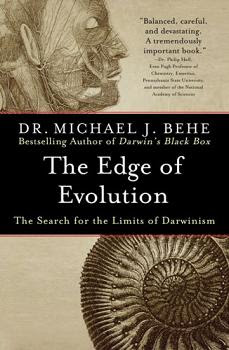Joseph A. Kuhn is a physician at the Baylor University Medical Center at Dallas. This is a Christian medical center associated with Baylor University in Waco, Texas. Joseph Kuhn published an article in a recent issue of
Baylor University Medical Center Proceedings:
Dissectring Darwinism.
Kuhn has an M.D. degree. He is not a scientist and he has no obvious expertise in biology and/or evolution. He is a Roman Catholic. He is definitely an Intelligent Design Creationist.
Let's look as what this IDiot has to say ...
The primary conflicts or anomalies with neo-Darwinian evolution lie in the failure of mutation and natural selection to account for the formation of DNA, the information of DNA, or the complexity of the human cell. In all fairness, many physicians, medical students, and college students have not been shown the weakness of Darwinian evolution. They haven’t been shown the failure of the Miller-Urey experiments to explain DNA, RNA, or protein formation; the paucity of fossil data; or the refutations of transitional species based on a growing biochemical understanding of complex systems and the limits of DNA mutation to account for the formation of new DNA, new chromosomes, and therefore new species.
In contrast, how is it possible that the majority of National Academy of Science members (who should know the above weaknesses) fully believe that random mutation and natural selection can explain the origin of DNA and the subsequent generation of a vast array of protein systems within complex cells? It is possible that the biologist, the paleontologist, and the anthropologist are each studying a small portion of the picture and do not have the education and training to see the full picture. More likely, their previous research relies on the established paradigm of Darwinian evolution to provide structure for their work. As the limitations of existing paradigms become apparent, adoption of a new paradigm typically requires at least a full generation, since existing practitioners and scientists often hold on to the old paradigm.
There's so much wrong here that I hardly know where to begin. First, biological evolution, whether it be the outmoded neo-Darwinian model or a more modern version, was never intended to explain the origin of life. We don't know how life originated but that has nothing to do with the truth and power of evolution as an explanatory mechanism.
Second, members of the National Academy of Science—and all other scientists in the USA and many other countries—are not stupid. The idea that they would all fail to see the truth about evolution because they "do not have the education and training to see the full picture" is silly beyond belief. The idea that they might be blind to the truth because they adhere to an incorrect Darwinian paradigm is ridiculous. The idea that a physician at a Christian university might be in a better position to recognize the truth about evolution is something that only a true IDiot could believe.
The standard IDiot talking point these days is that students and the general public are being misled because scientists won't teach all the problems and controversies concerning biological evolution. This is an attitude that completely ignores all the debate and discussion that has been taking place on the internet and in popular books, magazines, and journals over the past four decades. None of the problems and controversies have stood up to close analysis in spite of the fact they have been dogmatically defended by dozens of leading IDiots.
Of course Joseph Kuhn, the physician, knows nothing about this. That's why he writes ...
When the Texas State Board of Education voted to recognize the weaknesses of Darwinian evolution in explaining the origin of the species, it was a result of 3 full days of intense debate and scientific dispute. In 2011, when new textbooks were presented to the State Board of Education, 9 out of 10 failed to provide the mandated supplementary curricula, which would include both positive and negative aspects of evolution (44). Moreover, several of the textbooks continued to incorrectly promote the debunked Miller-Urey origin of life experiment, the long-discredited claims about nonfunctional appendix and tonsils, and the fraudulent embryo drawings from Ernst Haeckel. In essence, current biology students, aspiring medical students, and future scientists are not being taught the whole story. Rather, evidence suggests that they continue to receive incorrect and incomplete material that exaggerates the effect of random mutation and natural selection to account for DNA, the cell, or the transition from species to species.
The Texas State Board of Education guidelines do not propose teaching any other alternatives to Darwinian evolution. Rather, the students of tomorrow and teachers of today should appropriately recognize that there are weaknesses that have been pointed out by reasonable scientists. In this dissection of Darwinism, we have cut into the weaknesses of the fossil evidence for human evolution, the failure of the fossil data to demonstrate substantial transition species, and the awareness of the sudden formation of most species in a short window of time, with no significant subsequent variation. More importantly, this physician-perspective article emphasizes the extreme impossibility of the natural formation or self-formation of billions of nucleotides in a specific sequence, allowing for the coding of RNA and proteins in a complex cell with thousands of interrelated and irreducibly complex functions. The article also enlightens the reader regarding the conflicts and difficulty of using natural selection and mutation to explain the simultaneous or sequential changes in cellular DNA, involving entirely new strands of DNA and thousands of new proteins, which are necessary for the formation of new species.
It's hard to imagine what must be going on inside the head of someone who could write such drivel. Let's say that the Texas Board of Education succeeds in brainwashing students about the "weaknesses" of evolution. Is that going to change the minds of any expert who studies biological evolution for a living? Is that going to lead to a new generation of scientists who accept Intelligent Design Creationism? No, not even in Texas.
Only an IDiot could believe that forcing Intelligent Design Creationism down the throats of students in some parts of southern USA will eventually lead to a "paradigm shift" in thinking about evolution. Only an IDiot physician could believe that he knows more about evolution than the experts. In fairness, you've got to give the creationists some credit for convincing some, otherwise intelligent, people that 99.9% of all scientists are really, really stupid.
UPDATE:Jonathan Wells defends Joseph A. Kuhn, MD [
"Shut up," Coyne Explained].
[Hat Tip: Jerry Coyne in Creationist paper in a medical journal.]












